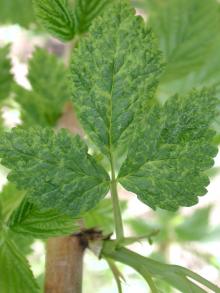See:
Blackberry (Rubus spp.) - Virus Diseases
Raspberry (Rubus spp.) - Crumbly Fruit
Raspberry (Rubus spp.) - Ringspot
Raspberry Cultivar Susceptibility
Cause There are several important virus diseases of raspberry and black raspberry in the Pacific Northwest. Pollen-borne viruses include raspberry bushy dwarf virus and strawberry necrotic shock virus (SNSV). SNSV is common but symptomless in field-run 'Munger' and 'Boysenberry'. SNSV will spread from infected 'Boysenberry' to immediately adjoining red raspberry rows, where it causes no obvious symptoms or crop loss. This virus is transmitted by thrips in strawberry and there is some evidence it can be transmitted by thrips to Rubus spp. since there can be low levels of transmission in plants that are not flowering. It can be detected serologically or by RT-PCR.
Tomato ringspot virus is not common but can be very damaging when it infects raspberry. It has not been observed in blackberry in the PNW, even in fields where blackberries were planted and which had severely declining red raspberry that was infected with tomato ringspot virus. It has been reported in blackberry in other parts of the world. The dagger nematode is the vector for the disease raspberry ringspot caused by the tomato ringspot virus. This virus has a broad host range, which means that the virus-carrying vector may be in the soil when a raspberry field is planted. In such cases symptoms may appear in the second or third year after planting.
Several viruses are spread by aphids. The raspberry mosaic virus disease complex, composed of five different viruses, is transmitted by the large raspberry aphid. It is more common in Washington than Oregon. 'Canby', 'Chilliwack', 'Comox', 'Nootka', and 'Skeena' are resistant to the vector aphid's colonization. A new biotype of the aphid appeared in the late 1990s that overcomes the resistance used in the British Columbia breeding program. The impact of this new aphid biotype is yet to be seen, but it is expected to be more important in Washington than Oregon. Raspberry leaf mottle virus (RLMV) and raspberry latent virus (RpLV) are aphid-vectored and involved with RBDV in the crumbly fruit disease. RLMV is considered the most widespread virus on raspberry in the PNW.
Black raspberry decline is a disease of major concern to black raspberry growers in Oregon caused by the North American strain of the black raspberry necrosis virus. This virus is vectored nonpersistently by the large raspberry aphid and the green peach aphid. Fields typically are in production for three or four growing seasons before they succumb to disease and no longer remain profitable. Black raspberry necrosis virus is symptomless in red raspberry but in mixed infections with other viruses leads to increased disease severity.
The large raspberry aphid (Amphorophora idaei) is initially more attracted to raspberry plants infected with black raspberry necrosis virus and raspberry leaf mottle virus and took more than 3 days longer to reach adulthood compared with those on uninfected plants. This altered behavior is beneficial for semi-persistently transmitted viral acquisition and transmission.
Symptoms Crumbly fruit is characterized by the abortion of many drupelets which causes the fruit to crumble at harvest, resulting in significant reductions of yield and fruit quality. Reduced plant growth and leaf patterns may also occur.
Ringspot symptoms vary from mottled, chlorotic, mosaic leaves to leaf curling and ring spotting. Infected plants often show no symptoms but have low vigor and yield. In the case of tomato ringspot virus, young leaves on primocanes often show a chevron pattern and ringspot early in the season.
Raspberry mosaic disease may cause mild leaf mottling, blistering, or vein banding. Certain cultivars may also be symptomless.
Black raspberry decline is initially displayed as leaf chlorosis and puckering. Eventually, the fruiting canes prematurely die back, resulting in rapid and severe reduction in yield.
Cultural control
- Use certified planting stock.
- Plant immune or resistant cultivars if available.
- Plant in large blocks to slow movement of pollenborne viruses into new plants, especially if fields in the immediate area are infected.
- Test for nematodes before planting and do not plant in soil containing Xiphinema spp.
- Control known insect vectors. Aphid flights peak in late April to early May and again in September, in Oregon and in mid-June in northern Washington. These are the most critical periods for controlling aphid vectors. See the PNW Insect Management Handbook for details.
References Martin, R.R., MacFarlane, S., Sabanadzovic, S., Quito, D., Poudel, B., and Tzanetakis, I.E. 2013. Viruses and virus diseases of Rubus. Plant Disease 97:169-182.
McMenemy, L. S., Hartley, S. E., MacFarlane, S. A., Karley, A. J., Shepherd, T., and Johnson, S. N. 2012. Raspberry viruses manipulate the behaviour of their insect vectors. Entomologia Experimentalis et Applicata, 144:56-68.


